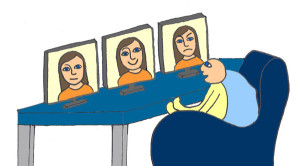Imagine you’re in a place you’ve never been before. You understand nothing and cannot interpret the facial expressions of people around you. Things are getting unpleasant: Are you hungry, afraid or angry because nobody cares about you? Your tummy is getting tense. Do you need to go to the loo,or are you just worried? You don’t know and when you ask somebody passing by, she looks as if she didn’t understand a word.
This is my way of helping you to imagine how an unhappy crying baby might feel. How it feels not being understood and not being able to understand. This is a situation every baby meets with now and then. Mum and Dad try to understand but the little one continues to feel troubled.
Dad says: “Perhaps it is the stomach. She might have swallowed some air”. Mum: “If you hadn’t come home late last night, I wouldn’t have worried. I’m sure Emily noticed how worried I was” The problem is that the baby cannot tell us how she is feeling. How are Mum and Dad to understand her?
One possible reply is that there is nothing to understand here. Sometimes babies are feeling well and sometimes not. Their bodies are not fully developed and this may cause them trouble. Surely, the baby has negative feelings but that is because his body fussing with him or her, so to speak.
But this explanation as to why Emily is screaming may be too simple. True, she has just begun an enormous developmental process. But, we do know that babies are sensitive to changes in the physical and psychological environment. An alteration in the body temperature or electrolyte balance can disturb the child. A change in the emotional environment can also disturb the baby. Most parents know about this complexity in an intuitive way, without ever having read books about it. Have a look at the pictures below!

It is easy to guess which feelings move about in these children, isn’t it? During pregnancy, the future mother gets prepared to become an “emotion reader” of her child. When the child is born, the father also starts to learn how to interpret the child’s signals. What is more difficult to know is how the child experiences, from within so to speak, things.
A baby is able to read emotional signals in a simple and spontaneous way. This has been demonstrated in many studies. Similarly, clinical experiences imply that babies, some more than others, are also sensitive to their mother’s facial expressions, for example of sadness, joy, vexation and calm. They seem to react if the mother’s voice is tense or calm, and if they are being held in a soft or irregular way. Some psychoanalysts, like Melanie Kleins supposed that the baby splits up his experiences concerning his parents into “good” and “bad” images. When the baby is feeling well, the “good parent” is in the forefront in the baby’s mind. On the other hand, when there is a pain in the stomach or when the child cannot fall to sleep, then the “silly” mother and father play the major role in the baby’s experience. If these “silly” or “bad” characters get stuck in the child’s mind, we can start talking about a ghost in the baby. Other theoreticians and researchers, like Daniel Stern, dispute that the baby has such a two-sided view of the world.

Many infant therapists have experienced that babies sometimes avoid the mother’s gaze. I have seen it myself with several babies of troubled or distressed mothers. The mother is asking: “Why doesn’t he look at me, doesn’t he like me?” Or, “What is it the baby doesn’t want to see? He is looking at other people’s eyes, so why not at those of his own Mum?” I think the answer is that he is avoiding a“ghost”, that is, an image has been created inside him of someone who is “bad” or incomprehensible. Perhaps this is how the mother seems to the little one, that is, when he does not manage to get in contact with her. This is what I called “the baby’s ghost”.
